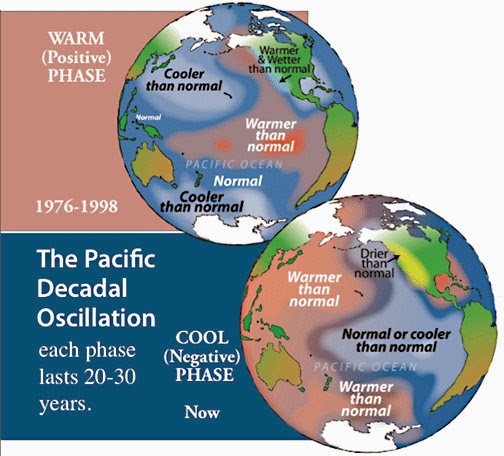Pacific Decadal Oscillation (PDO) 07/05/2019 – Posted in: Daily News
PACIFIC DECADAL OSCILLATION
For: Preliminary & Mains
Topics covered: PDO, Factors affecting Monsoon
News Flash
Northeast India, one of the wettest places on the Earth has been experiencing rapid drying, especially in the last 30 years.
Some places which used to get as high as 3,000 mm of rain during the monsoon season have seen a drop of about 25-30%.
- The decreasing monsoon rainfall is associated with natural changes in the subtropical Pacific Ocean.
- Researchers also found that changes in the Pacific decadal oscillation (PDO) — a pattern of fluctuations in the ocean, particularly over the north Pacific basin — are mainly associated with this declined rainfall.
- The team used observed rainfall and sea surface temperature data for the period 1901-2014 for the study.
- The reduction in rainfall during a major part of the last 114 years may be associated with global man-made factors, while the trend during the last 36 years is associated with natural phenomena.
- Only about 7% of the rainfall in this region is associated with local moisture recycling, which means that anthropogenic activities can affect only this small percentage.
- Rapid drying is a part of interdecadal variability of monsoonal rainfall which is strongly associated with the PDO.
Pacific Decadal Oscillation
- Fisheries scientist Steven Hare coined the term “Pacific Decadal Oscillation” (PDO) in 1996.
- The “Pacific Decadal Oscillation” (PDO) is a long-lived El Niño-like pattern of Pacific climate variability.
- The PDO is detected as warm or cool surface waters in the Pacific Ocean, north of 20°N.
- PDO and El Niño/Southern Oscillation (ENSO) have similar spatial climate fingerprints yet the major difference is that PDO persists for 20-30 years while the typical ENSO persists for 6 to 18 months.
- The primary climatic fingerprints of the PDO are most visible in the North Pacific/North American sector, while secondary signatures exist in the tropics.
- The primary climatic fingerprints of the ENSO are visible in tropics while secondary are visible in North Pacific/North American sector.
- The PDO has two cycles, viz. Cold Cycle and Warm Cycle, very much similar to La Nina and El Nino of the ENSO cycle.
- “Cool” PDO regimes prevailed from 1890-1924 and again from 1947-1976.
- “Warm” PDO regimes dominated from 1925-1946 and from 1977 through (at least) the mid-1990’s.
Major changes in northeast Pacific marine ecosystems have been correlated with phase changes in the PDO; warm eras have seen enhanced coastal ocean biological productivity in Alaska and inhibited productivity off the west coast of the contiguous United States, while cold PDO eras have seen the opposite north-south pattern of marine ecosystem productivity.
Source: The Hindu
You can follow us on LinkedIn and for more updates related to UPSC IAS Preparation, Like our Facebook Page and subscribe our Diligent IAS Youtube Channel
Also Read Related Daily News


